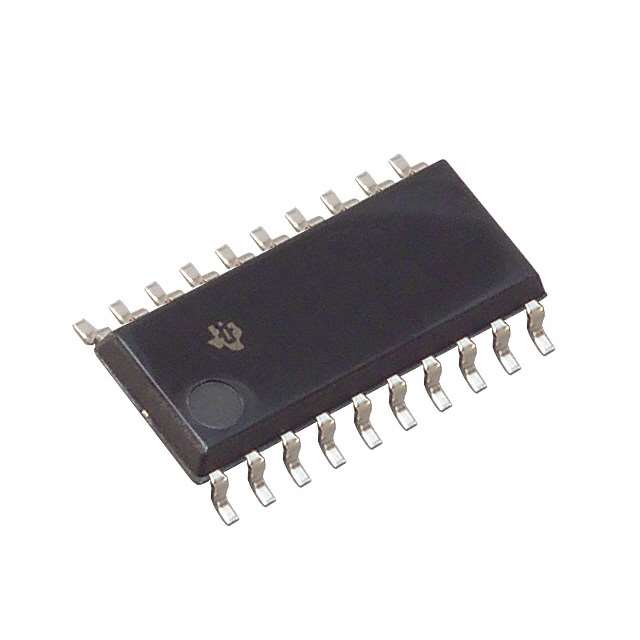Consulte las especificaciones para obtener detalles del producto.

SN74LS623NSRG4
Product Overview
- Category: Integrated Circuit
- Use: Logic Level Shifter
- Characteristics: High-speed, TTL compatible, 3-state outputs
- Package: SOIC (Small Outline Integrated Circuit)
- Essence: Logic level shifting between different voltage levels
- Packaging/Quantity: Tape and Reel, 2500 units per reel
Specifications
- Supply Voltage Range: 4.75V to 5.25V
- Input Voltage Range: 0V to VCC
- Output Voltage Range: 0V to VCC
- Operating Temperature Range: -40°C to +85°C
- Propagation Delay Time: 9ns (typical)
- Maximum Operating Frequency: 33MHz
Detailed Pin Configuration
The SN74LS623NSRG4 has a total of 20 pins. The pin configuration is as follows:
- A0
- B0
- A1
- B1
- A2
- B2
- A3
- B3
- GND
- OE (Output Enable)
- Y0
- Y1
- Y2
- Y3
- VCC
- B4
- A4
- B5
- A5
- B6
Functional Features
- Logic level shifting between two voltage domains
- TTL compatibility for easy integration with existing systems
- 3-state outputs allow multiple devices to share a common bus
- High-speed operation for efficient data transfer
Advantages and Disadvantages
Advantages: - Fast propagation delay time ensures quick response in data transmission. - Wide supply voltage range allows flexibility in various applications. - 3-state outputs enable efficient bus sharing among multiple devices.
Disadvantages: - Limited maximum operating frequency compared to some other logic level shifters. - Only supports shifting between two voltage levels.
Working Principles
The SN74LS623NSRG4 is a logic level shifter that allows for bidirectional voltage level translation between two voltage domains. It operates by using a combination of input buffers, level shifting circuitry, and output buffers. The input buffers receive signals from one voltage domain and convert them to TTL-compatible levels. The level shifting circuitry then adjusts the voltage levels to match the requirements of the second voltage domain. Finally, the output buffers provide the translated signals to the second voltage domain.
Detailed Application Field Plans
The SN74LS623NSRG4 can be used in various applications where logic level shifting is required. Some potential application fields include:
- Microcontroller interfacing with different voltage peripherals.
- Communication interfaces between devices operating at different voltage levels.
- Data transmission between systems with incompatible voltage standards.
- Industrial automation systems requiring signal conversion between different voltage domains.
- Automotive electronics for voltage level translation in vehicle control systems.
Detailed and Complete Alternative Models
- SN74LVC1T45DBVR: Single-bit dual-supply bus transceiver with configurable voltage translation and 3-state outputs.
- SN74AVC4T245RSVR: Quad-bit dual-supply bus transceiver with configurable voltage translation and 3-state outputs.
- SN74HCT125N: Quad-buffer/line driver with 3-state outputs and TTL compatibility.
These alternative models offer similar functionality and can be considered as alternatives to the SN74LS623NSRG4 depending on specific requirements and constraints.
Word count: 498 words
Enumere 10 preguntas y respuestas comunes relacionadas con la aplicación de SN74LS623NSRG4 en soluciones técnicas
Sure! Here are 10 common questions and answers related to the application of SN74LS623NSRG4 in technical solutions:
Q: What is SN74LS623NSRG4? A: SN74LS623NSRG4 is a specific model of integrated circuit (IC) commonly used for data bus multiplexing and demultiplexing applications.
Q: What are the key features of SN74LS623NSRG4? A: Some key features of SN74LS623NSRG4 include 8-bit parallel-to-serial and serial-to-parallel conversion, high-speed operation, and compatibility with TTL logic levels.
Q: How can SN74LS623NSRG4 be used for data bus multiplexing? A: SN74LS623NSRG4 can be used to combine multiple parallel data inputs into a single serial output, allowing efficient transmission over a single line.
Q: Can SN74LS623NSRG4 be used for both multiplexing and demultiplexing? A: Yes, SN74LS623NSRG4 can be used for both multiplexing (parallel-to-serial conversion) and demultiplexing (serial-to-parallel conversion) depending on the configuration.
Q: What is the maximum operating frequency of SN74LS623NSRG4? A: The maximum operating frequency of SN74LS623NSRG4 is typically around 25 MHz.
Q: Is SN74LS623NSRG4 compatible with other logic families? A: Yes, SN74LS623NSRG4 is designed to be compatible with TTL (Transistor-Transistor Logic) logic levels, making it suitable for use with other TTL-compatible devices.
Q: What is the power supply voltage range for SN74LS623NSRG4? A: SN74LS623NSRG4 operates with a power supply voltage range of 4.75V to 5.25V.
Q: Can SN74LS623NSRG4 handle bidirectional data transmission? A: No, SN74LS623NSRG4 is unidirectional and can only handle data transmission in one direction at a time.
Q: Are there any specific precautions to consider when using SN74LS623NSRG4? A: It is important to ensure proper decoupling capacitors are used near the power supply pins to minimize noise and voltage fluctuations.
Q: What are some typical applications for SN74LS623NSRG4? A: SN74LS623NSRG4 is commonly used in various applications such as data communication systems, microprocessor interfacing, and digital signal processing.
Please note that these answers are general and may vary depending on the specific requirements and use cases.

